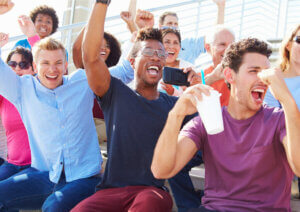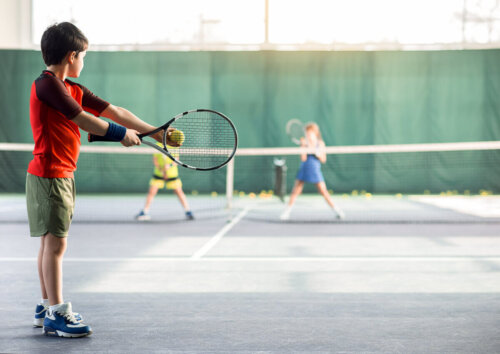How Audience Presence Influences Athletic Performance

The influence that the audience has on an athletic performance has been highly studied in sports. No team, athlete, or referee can say that the audience’s behavior doesn’t affect them in any way. Spectators encourage athletes and are able to bring out their best version in difficult situations. Nevertheless, some athletes perceive audience presence as added pressure, which affects their performance.
Generally speaking, audience presence doesn’t necessarily have to increase or decrease performance. Their influence can be positive or negative, depending on both personal and environmental factors.
Audience presence is pretty much a given in most sports competitions. For this reason, we decided to analyze the influence of audience presence on athletic performance.
Audience presence and athlete performance
Numerous investigations have found that audience presence in competitions helps athletes perform better. Below, we expose the psychological processes that could explain this relationship.
1. Social facilitation
Social facilitation is people’s tendency to do better when other people are watching them rather than alone.
This phenomenon appears when the task is simple or highly automated. On the contrary, in the case of a task that a person hasn’t yet mastered, it’s likely that audience presence will have the opposite effect. In other words, it’ll negatively affect their performance.
Applied to sports, in a match with an audience, a soccer player can make better short passes or head shots because they’re simple. However, they could also make bad long passes or free kicks, as these tasks are more complicated.

2. Competing in a familiar environment
Although it seems like a very obvious factor, an athlete’s performance will depend on whether they compete at home or away. Typically, athletes perform better and are more comfortable when they compete in a familiar environment.
In fact, the term home advantage has been widely studied in many sports. For example, researchers from the Autonomous University of Madrid discovered in a study they conducted that the home advantage of the home team is 56 percent in soccer.
Not only that but the best-classified and highest-scoring teams have the most home advantage. In other words, they’re the most sensitive to the audience’s effect.
3. Audience presence increases the sense of belonging
The presence of spectators in the stands cheering on an athlete is very important, as they’ll feel loved and less nervous before competing.
In unfamiliar situations, it’s normal for athletes to feel anxiety, and this isn’t beneficial for performance. On the other hand, feeling supported by people, even if they’re strangers, increases the feeling of control and reduces uncertainty.
This is especially important when mistakes are made. If the audience acts as if nothing happened and cheers the athlete on to try again, they’ll feel more motivated to not give up and make a bigger effort.
Audience presence can worsen sports performance
As you’ve already seen, audience presence has the power to improve performance. However, several studies have also evidenced the opposite effect. The audience can also hinder an athlete’s ability to give the very best of themselves.
1. Social inhibition
Social inhibition is the flip side of social facilitation. It occurs when the presence of other people worsens a person’s performance. Mainly, this effect occurs in difficult tasks or tasks that a person is still learning.
The presence of other people increases an athlete’s activation. When the task is complex or the athlete hasn’t mastered it yet, this increased activation is detrimental, since the athlete is excessively tense and worried. In these cases, breathing techniques can help reduce that added tension.

2. Fear of evaluation
Many people fear making mistakes in front of others. Nobody likes to disappoint or feel that they’ve failed those who expect a lot from them.
Athletes create expectations and beliefs depending on how they’re being perceived by the public. Many athletes care a lot about making a good impression. Also, when they have low self-confidence or are very self-demanding, making a good impression becomes an anxiety-generating concern.
3. The distraction effect
Spectators can cheer on an athlete during a competition with the intention of making them feel loved. However, they can unconsciously become a distraction that makes it difficult for the athlete to stay focused on relevant aspects during a competition.
Distraction doesn’t affect all athletes equally. According to a study by professionals at the University of Arizona, this effect is more likely to appear in amateur athletes.
In contrast, professional athletes are able to more effectively ignore the audience, even when they’re behaving loudly or trying to get their attention.
Learn to take advantage of audience presence
Competing under the watchful eye of other people can play for or against you. Thus, you must be aware of the influence of audience presence and try to turn it into something positive.
To do this, you need to work on the psychological factors that it tends to affect, such as self-confidence, motivation, and concentration. This way, you’ll be able to use the audience’s push in your favor and, thus, achieve better results.
The influence that the audience has on an athletic performance has been highly studied in sports. No team, athlete, or referee can say that the audience’s behavior doesn’t affect them in any way. Spectators encourage athletes and are able to bring out their best version in difficult situations. Nevertheless, some athletes perceive audience presence as added pressure, which affects their performance.
Generally speaking, audience presence doesn’t necessarily have to increase or decrease performance. Their influence can be positive or negative, depending on both personal and environmental factors.
Audience presence is pretty much a given in most sports competitions. For this reason, we decided to analyze the influence of audience presence on athletic performance.
Audience presence and athlete performance
Numerous investigations have found that audience presence in competitions helps athletes perform better. Below, we expose the psychological processes that could explain this relationship.
1. Social facilitation
Social facilitation is people’s tendency to do better when other people are watching them rather than alone.
This phenomenon appears when the task is simple or highly automated. On the contrary, in the case of a task that a person hasn’t yet mastered, it’s likely that audience presence will have the opposite effect. In other words, it’ll negatively affect their performance.
Applied to sports, in a match with an audience, a soccer player can make better short passes or head shots because they’re simple. However, they could also make bad long passes or free kicks, as these tasks are more complicated.

2. Competing in a familiar environment
Although it seems like a very obvious factor, an athlete’s performance will depend on whether they compete at home or away. Typically, athletes perform better and are more comfortable when they compete in a familiar environment.
In fact, the term home advantage has been widely studied in many sports. For example, researchers from the Autonomous University of Madrid discovered in a study they conducted that the home advantage of the home team is 56 percent in soccer.
Not only that but the best-classified and highest-scoring teams have the most home advantage. In other words, they’re the most sensitive to the audience’s effect.
3. Audience presence increases the sense of belonging
The presence of spectators in the stands cheering on an athlete is very important, as they’ll feel loved and less nervous before competing.
In unfamiliar situations, it’s normal for athletes to feel anxiety, and this isn’t beneficial for performance. On the other hand, feeling supported by people, even if they’re strangers, increases the feeling of control and reduces uncertainty.
This is especially important when mistakes are made. If the audience acts as if nothing happened and cheers the athlete on to try again, they’ll feel more motivated to not give up and make a bigger effort.
Audience presence can worsen sports performance
As you’ve already seen, audience presence has the power to improve performance. However, several studies have also evidenced the opposite effect. The audience can also hinder an athlete’s ability to give the very best of themselves.
1. Social inhibition
Social inhibition is the flip side of social facilitation. It occurs when the presence of other people worsens a person’s performance. Mainly, this effect occurs in difficult tasks or tasks that a person is still learning.
The presence of other people increases an athlete’s activation. When the task is complex or the athlete hasn’t mastered it yet, this increased activation is detrimental, since the athlete is excessively tense and worried. In these cases, breathing techniques can help reduce that added tension.

2. Fear of evaluation
Many people fear making mistakes in front of others. Nobody likes to disappoint or feel that they’ve failed those who expect a lot from them.
Athletes create expectations and beliefs depending on how they’re being perceived by the public. Many athletes care a lot about making a good impression. Also, when they have low self-confidence or are very self-demanding, making a good impression becomes an anxiety-generating concern.
3. The distraction effect
Spectators can cheer on an athlete during a competition with the intention of making them feel loved. However, they can unconsciously become a distraction that makes it difficult for the athlete to stay focused on relevant aspects during a competition.
Distraction doesn’t affect all athletes equally. According to a study by professionals at the University of Arizona, this effect is more likely to appear in amateur athletes.
In contrast, professional athletes are able to more effectively ignore the audience, even when they’re behaving loudly or trying to get their attention.
Learn to take advantage of audience presence
Competing under the watchful eye of other people can play for or against you. Thus, you must be aware of the influence of audience presence and try to turn it into something positive.
To do this, you need to work on the psychological factors that it tends to affect, such as self-confidence, motivation, and concentration. This way, you’ll be able to use the audience’s push in your favor and, thus, achieve better results.
All cited sources were thoroughly reviewed by our team to ensure their quality, reliability, currency, and validity. The bibliography of this article was considered reliable and of academic or scientific accuracy.
-
García, M. S., Aguilar, O. G., Romero, J. F., & Marques, P. S. (2015). Ventaja de jugar en casa en el fútbol español (1928-2011). Revista Internacional de Medicina y Ciencias de la Actividad Física y del Deporte/International Journal of Medicine and Science of Physical Activity and Sport, 15(57), 181-194.
-
Gray, R. (2004). Attending to the execution of a complex sensorimotor skill: Expertise differences, choking, and slumps. Journal of Experimental Psychology: Applied, 10(1), 42.
-
Hill, D. M., Hanton, S., Matthews, N., & Fleming, S. (2010). Choking in sport: A review. International Review of Sport and Exercise Psychology, 3(1), 24-39.
This text is provided for informational purposes only and does not replace consultation with a professional. If in doubt, consult your specialist.








